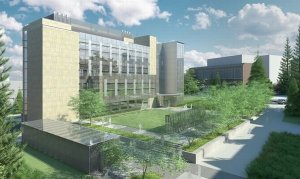Oct 9 2009
University of Washington leaders today officially broke ground on a molecular engineering building. "It's incredibly exciting to see the building become a reality," said Matthew O'Donnell, Frank + Julie Jungers Dean of the College of Engineering. "This will be the first facility in the country dedicated to molecular engineering."
 Architects' rendition of the east face of the molecular engineering building. ZGF Architects
Architects' rendition of the east face of the molecular engineering building. ZGF Architects
The completed building will consist of a 28,000-square-foot basement, an 8,000-square-foot sub-basement, and four above-ground levels each measuring about 12,000 square feet. The total building is about 90,000 square feet including hallways, utilities and common spaces.
The large underground space, protected from vibrations and electromagnetic interference, will be the largest such lab space on the West Coast. Above it will be a courtyard, and the above-ground building with preparatory laboratories and flexible research and teaching space.
The groundbreaking ceremony, at the site on Stevens Way near the west entrance to campus, included O'Donnell, UW Provost Phyllis Wise, UW Regent Bill Gates, Sr. and UW President Emeritus Lee Huntsman. Construction is now underway. The projected occupancy date is 2012.
Molecular engineering, sometimes called molecular manufacturing or molecular systems, is very small-scale construction made possible by advances in chemical synthesis and nanotechnology.
Engineers design individual functional molecules, or systems of molecules, on a computer and then create them according to plan. They can also synthesize machines where each working part is an individual molecule. The approach is to design molecular systems that can sense their surroundings and act accordingly. Such tiny systems can, for example, provide the working parts for flexible, cheap, efficient solar cells.
The current estimated project cost is $78 million. That figure includes construction, design and other expenses. Funding sources include state and internal UW funds, as well as debt and private gifts.
The building is expected to meet at least a LEED silver rating for energy savings, water efficiency, carbon dioxide emissions reduction and other measures. Designs include natural ventilation in the office spaces, a partial green roof, natural lighting and storm water management, all of which may ultimately qualify for an even higher LEED rating.
The design is by ZGF Architects of Seattle.
The builder is Hoffman Construction Company of Seattle. Construction will employ 150 people on the job site at its peak, with an approximately equal number of people working off-site, said Trevor Thies, project operations manager of Hoffman Construction. The UW's project manager is Steve Tatge, senior project manager in the UW's Capital Projects Office.
The building's location was chosen partly because the natural vibration and electromagnetic interference are low at that site. Researchers will be making very sensitive measurements and any movement can interfere with the accuracy. The foundation will incorporate an extra-thick concrete slab and shielding from electromagnetic waves, and the building's utilities and elevators are engineered to minimize physical vibrations in the lab space.
"All of this adds to the cost of the building, but it also adds value," said Greg Miller, the College of Engineering's associate dean for infrastructure.
Long-term plans include a second building connected to the first. The second building would be slightly smaller than the first and include mainly teaching and office space.
"Molecular engineering is going to be right in the middle of a lot of the big societal problems -- energy, health care, communications," O'Donnell said. "I think it's going to be as central to new technologies in this century as mechanical, electrical, chemical and materials engineering were to technologies developed in the last century."
Energy and medicine are areas of immediate application, O'Donnell said. UW bioengineers, for instance, are designing molecules that can enter the body, recognize diseased cells and then deliver a genetic or other therapy to only those cells.
"Molecular medicine is a promise that has been out there for almost 30 years," O'Donnell said. "These are the systems that are going to be able to deliver molecular medicine."
Molecular engineering will not be a new department. Faculty in the departments of materials science, chemistry, chemical engineering and bioengineering are expected to be major users of the space, but it will be available to faculty from across campus as well as external research partners. A new UW Institute of Molecular Engineering & Sciences, expected to launch in early 2010, will oversee the facility.
The building will provide office space for graduate students and postdoctoral researchers; faculty will use it as a secondary base.